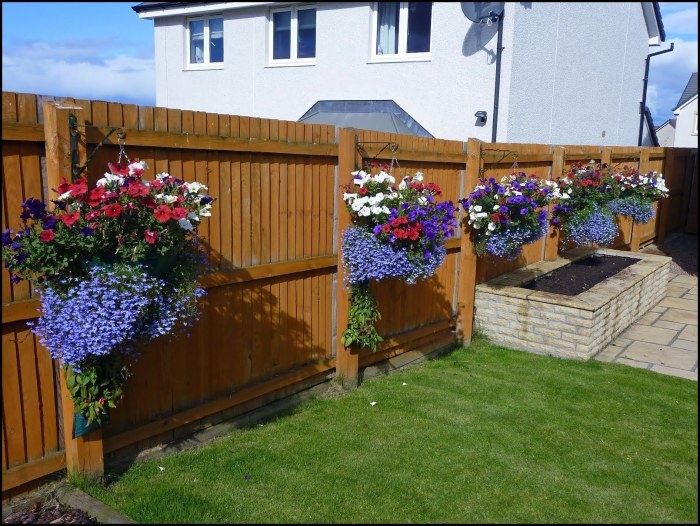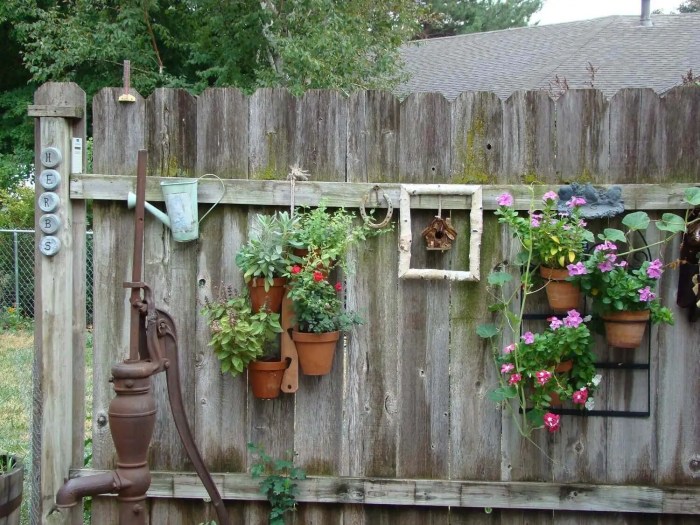10 hanging plants on fence – Transform your fence into a vibrant oasis with these 10 hanging plants. From cascading blooms to lush greenery, these plants offer a variety of textures, colors, and scents to enhance your outdoor space.
Whether you’re looking to create a privacy screen, add height, or simply bring life to your fence, these hanging plants are sure to do the trick.
Hanging Plants Suitable for Fence Decor

Hanging plants can add a touch of elegance and charm to any fence. They can help to soften the look of a fence, create privacy, and provide a splash of color. There are many different types of hanging plants that are suitable for fence decoration, each with its own unique appearance and care requirements.
When selecting hanging plants for a fence, there are a few factors to consider, such as sunlight exposure, wind tolerance, and aesthetic appeal. It is also important to choose plants that are easy to care for and that will not require a lot of maintenance.
Hanging Plants for Sunny Fences
- Petuniasare a popular choice for hanging baskets and window boxes. They come in a wide range of colors and bloom profusely from spring to fall. Petunias prefer full sun and well-drained soil.
- Impatiensare another good choice for sunny fences. They are shade-tolerant, but they will bloom best in full sun. Impatiens come in a variety of colors and have a long blooming period.
- Geraniumsare a classic choice for hanging baskets. They are heat-tolerant and drought-tolerant, making them a good choice for hot, dry climates. Geraniums come in a variety of colors and bloom from spring to fall.
Hanging Plants for Shady Fences
- Fuchsiasare a beautiful choice for hanging baskets. They prefer shade or partial shade and have a long blooming period. Fuchsias come in a variety of colors and have delicate, bell-shaped flowers.
- Begoniasare another good choice for shady fences. They come in a variety of colors and have a long blooming period. Begonias prefer moist, well-drained soil.
- Fernsare a great way to add a touch of greenery to a shady fence. They come in a variety of shapes and sizes and are relatively easy to care for.
Hanging Plants for Wind Tolerance
- Vincais a trailing plant that is known for its wind tolerance. It comes in a variety of colors and has a long blooming period. Vinca prefers full sun or partial shade and well-drained soil.
- Lantanais another good choice for windy fences. It is a heat-tolerant and drought-tolerant plant that comes in a variety of colors. Lantana prefers full sun and well-drained soil.
- Scaevolais a trailing plant that is known for its wind tolerance. It comes in a variety of colors and has a long blooming period. Scaevola prefers full sun or partial shade and well-drained soil.
Design Ideas for Hanging Plants on Fence
Transform your fence into a vibrant vertical garden by incorporating hanging plants. Arrange them strategically to create a cascading effect, adding depth and movement to the fence. Consider using trellises or hooks to elevate the plants, creating a more dynamic display.
10 hanging plants on fence can add a touch of greenery and life to any outdoor space. Whether you’re looking for plants that will thrive in full sun or shade, there are plenty of options to choose from. For those who prefer plants that can tolerate low light conditions, consider 10 hanging plants good in shade , such as ferns, spider plants, and peace lilies.
These plants will add a touch of elegance and sophistication to your fence, while also providing some much-needed shade on hot days. 10 hanging plants on fence can be a great way to add some color and interest to your yard or patio.
Experiment with different heights and varieties of plants to add visual interest and contrast.
Creating a Cascading Effect
- Suspend plants at varying heights, allowing their trailing vines to cascade gracefully over the fence.
- Use hanging baskets or macrame hangers to create a layered effect, with plants spilling over the edges.
- Plant trailing varieties such as ivy, petunias, or lobelia to enhance the cascading effect.
Maintenance and Care Tips
Maintaining the health and beauty of hanging plants on a fence requires regular attention to their watering, fertilizing, and pruning needs. By following proper care practices, you can ensure your plants thrive and enhance the visual appeal of your outdoor space.
For those looking to enhance their outdoor space, consider incorporating hanging plants on a fence. These verdant additions bring life and color to any vertical surface. If you desire trailing greenery, explore 10 hanging plants long , known for their cascading vines that gracefully drape over the fence.
This creates a stunning visual effect, adding depth and dimension to your garden.
Watering
The frequency of watering will vary depending on the plant species, the size of the container, and the weather conditions. Generally, hanging plants require more frequent watering than ground-level plants due to their limited soil volume. During hot and dry periods, water your plants thoroughly until water drains from the drainage holes.
Allow the soil to dry out slightly between waterings to prevent overwatering.
Hanging plants on a fence can add a touch of greenery and beauty to any outdoor space. For those looking for inspiration, a comprehensive 10 hanging plants list provides a range of options, from lush ferns to vibrant flowers. These versatile plants can be easily incorporated into a fence, creating a stunning vertical garden that will enhance the ambiance of any backyard or patio.
Fertilizing, 10 hanging plants on fence
Fertilizing hanging plants on a fence is essential for providing them with the nutrients they need for healthy growth. Choose a balanced liquid fertilizer and apply it according to the manufacturer’s instructions. Fertilize your plants every two to four weeks during the growing season, and reduce or stop fertilizing during the dormant season.
Pruning
Regular pruning helps maintain the shape and size of hanging plants and encourages new growth. Use sharp, clean shears to remove dead or damaged leaves and stems. Prune back overgrown plants to keep them within the desired size and shape.
Pruning can also help promote bushier growth and improve airflow, which can reduce the risk of disease.
Troubleshooting Common Problems and Pests
Hanging plants on a fence may encounter various problems and pests. Some common issues include:
- Yellowing leaves:This can indicate overwatering, underwatering, or nutrient deficiency. Check the soil moisture and adjust your watering schedule accordingly. Fertilize your plants regularly to ensure they are receiving the necessary nutrients.
- Brown tips on leaves:This can be caused by underwatering or exposure to direct sunlight. Water your plants more frequently and provide them with some shade during the hottest part of the day.
- Aphids:These small, soft-bodied insects can infest plants and feed on their sap. Use insecticidal soap or neem oil to control aphids.
- Mealybugs:These white, cottony insects can also infest plants and suck their sap. Use rubbing alcohol to remove mealybugs and spray your plants with insecticidal soap or neem oil.
Seasonal Considerations: 10 Hanging Plants On Fence

Hanging plants on a fence require special care during different seasons to ensure their health and longevity.
During extreme heat, it’s crucial to provide ample shade and water to prevent wilting and scorching. Misting the plants regularly can also help cool them down. In cold climates, protect plants from frost and wind by wrapping them in burlap or using frost blankets.
Water sparingly during cold spells.
Overwintering
In areas with harsh winters, overwintering hanging plants is essential. Move plants indoors or to a protected area such as a greenhouse. Reduce watering frequency and provide minimal light to encourage dormancy. Prune dead or damaged foliage and check for pests regularly.
DIY Projects and Inspiration

Unlock your creativity with DIY projects that transform your fence into a vibrant oasis. Embrace the art of repurposing materials to create unique displays that showcase your hanging plants.
Hanging Planter with Macrame
Craft a bohemian masterpiece by weaving macrame cords into a sturdy hanging planter. Use thick, durable cords to support the weight of your plants. Start by creating a series of knots at the top, then weave the cords together to form a diamond pattern.
Secure the bottom with a series of square knots to create a stable base for your plant.
Repurposed Ladder Display
Give an old ladder a new life by transforming it into a charming plant display. Paint the ladder in a fresh color or leave it rustic for a vintage touch. Hang plants from the rungs using S-hooks or macrame hangers.
Vary the heights and sizes of the plants to create a visually appealing arrangement.
Wall-Mounted Tiered Planter
Maximize vertical space with a tiered planter mounted to your fence. Construct a series of wooden boxes of varying sizes and attach them to the fence with brackets. Paint or stain the boxes to match your decor and arrange plants in a cascading effect from top to bottom.
Closing Summary
With proper care and maintenance, these hanging plants will thrive on your fence for years to come. So, embrace the beauty of nature and add some greenery to your outdoor space today!
FAQ Compilation
What are the best hanging plants for a fence?
Some of the best hanging plants for a fence include petunias, geraniums, impatiens, lobelia, and begonias.
How do I care for hanging plants on a fence?
Hanging plants on a fence require regular watering, fertilizing, and pruning. Water the plants deeply and regularly, especially during hot weather. Fertilize the plants monthly with a balanced fertilizer. Prune the plants regularly to remove dead or damaged leaves and stems.
How do I create a cascading effect with hanging plants on a fence?
To create a cascading effect with hanging plants on a fence, use plants with long, trailing stems. Plant the plants in hanging baskets or pots and suspend them from hooks or brackets on the fence. The plants will naturally cascade down the fence, creating a beautiful and eye-catching display.